Warehousing requirement to grow at 8% CAGR by 2020 in top 7 markets: Knight Frank India

Sept 30, 2016: The second edition India Warehousing Market Report 2016 by Knight Frank India unravels the present scenario of the Indian logistics sector along with providing a definitive view on the country’s top seven warehousing markets which includes Mumbai, NCR, Bengaluru, Chennai, Pune, Hyderabad and Ahmedabad. The warehousing space requirement to grow at a CAGR of 8 percent by 2020 in top 7 markets. The report highlights the present scenario of the Indian logistics sector along with providing a definitive view of Mumbai Metropolitan Regions warehousing clusters.
According to the report, the total warehousing space requirement in the country’s top seven markets is expected to grow from 621 million square feet in 2016 to 839 million square feet by 2020. Pune offers the best investment opportunity in India today with estimated investment returns to the tune of 22-24 per cent per annum. Warehousing requirements of the e-tail segment to double from 14 million square feet in 2016 to 29 million square feet in 2020. Auto & Ancillary and Chemical & Pharmaceutical sectors emerge as largest demand drivers of warehousing space. 17 million square feet of space transacted annually in the top warehousing markets of the country as of today. Goods and Services Tax (GST) and Make in India set to give a thrust from the Manufacturing sector for Warehouse spaces.
The rent across the warehouse facilities in Bhiwandi is in the range of Rs 10 to Rs 16 per square feet per month and in Panvel is in the range of Rs 17 to Rs 25 per square feet per month. The leasable warehousing market in Mumbai is estimated at around 60 million square feet and the annual transaction volume for the market is approximately three million square feet.
Speaking about the report, Balbir Singh Khalsa, national director - industrial, Knight Frank India, said, “With a renewed focus on manufacturing and infrastructure evelopment, warehousing sector has shown a tremendous traction in the last couple of years. Large consumption base and port driven Export-Import (EXIM) cargo movement has resulted in the development of two major warehousing clusters namely Bhiwandi and Panvel. Being strategically located within MMR, Bhiwandi is in close proximity to the large consump Warehousing space requirement to grow at a CAGR of 8% by 2020 in top 7 markets of India: Knight Frank India tion markets of Mumbai, Thane city and Navi Mumbai. However, being an unplanned warehousing cluster spread across several densely populated villages, the complexities of developing and operating a warehouse have also increased in Bhiwandi. On the other hand, Panvel due to its proximity to the country’s largest sea port (Jawaharlal Nehru Port Trust) is dominated by industrial warehouses and container freight stations. However, the unviability of land prices closer to Palaspe will push warehouse development further south towards the periphery of the Mumbai-Goa Highway, where land prices are still feasible.”
Dr Samantak Das, chief economist & national director - research, Knight Frank India added, “Mumbai has been the country’s commercial capital for a long time. However, with rising population and increasing dominance of the service sector, industrial activity is moving outside the city. Mumbai market’s warehousing requirement is estimated at 155 million square feet of which the manufacturing sector accounts for 120 million square feet followed by the retail sector at 34 million square feet. Of the total manufacturing-led requirement, chemicals and pharmaceutical contribute the largest (17 percent) followed by the auto and auto ancillary (9 percent) and metals (10 percent) sectors. On the consumption-led warehousing front, apparel, sportswear and footwear category contributes 34 percent followed by foods and beverages segment (15 percent) and daily needs category (16 percent). With e-tail commanding a share of 7 percent in the consumption led warehousing requirement, we believe it will increase further in the total retail spending of consumers.”




